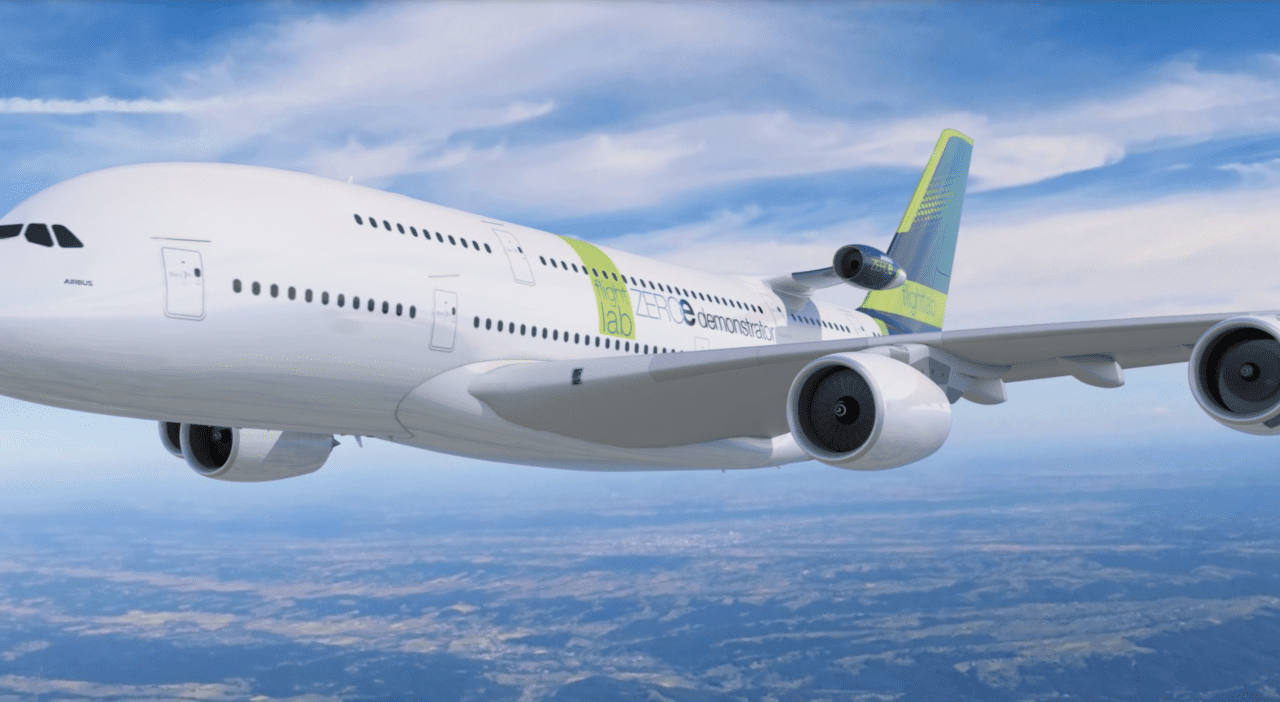
The Airbus A380 testbed will be used for the company’s new hydrogen demonstration program in partnership with CFM International. (Photo: Airbus)
In an agreement with CFM International, Airbus is beginning a hydrogen demonstration program, with the first flights taking place in the next five years. CFM International—a joint company between Safran Aircraft Engines and GE—will modify a GE Passport turbofan to enable the combustor, fuel system, and control system to operate on hydrogen. Both Airbus and CFM are committed to pursuing net-zero carbon emissions for the aviation industry by 2050.
Airbus and CFM will collaborate in testing the direct combustion engine fueled by hydrogen, according to the announcement from Airbus, both via ground and flight tests. They expect the engine to enter into service on a zero-emission aircraft by 2035. Airbus is providing the A380 flying testbed for testing the hydrogen combustion engine in cruise mode. The company’s facilities in France and Germany will supply liquid hydrogen tanks. Airbus will also oversee flight testing in addition to determining the requirements of the hydrogen propulsion system.
Airbus Chief Technical Officer Sabine Klauke remarked in the company’s press release that the partnership agreement with CFM is the biggest step Airbus has taken to accelerate hydrogen-powered flight since they revealed their ZEROe concepts in 2020. Airbus introduced its ZEROe demonstrator, the A380 MSN1, this week. The aircraft will carry four liquid hydrogen tanks and the hydrogen combustion engine will be mounted on the rear fuselage.

Before the flight test is conducted with the A380 platform, CFM will perform a ground test program with the GE engine. The GE Passport turbofan’s advantages for the hydrogen demonstration program include its size, advanced turbomachinery, and fuel flow capability. (Photo: GE)
Exploring the capabilities of hydrogen combustion is one of CFM International’s key areas of focus, having launched the Revolutionary Innovation for Sustainable Engines (RISE) Technology Demonstration Program in June 2021. The goals of the RISE program include “reducing fuel consumption and CO2 emissions by more than 20% compared to today’s most efficient engines, as well as ensuring compatibility with alternative energy sources like Sustainable Aviation Fuels (SAF) and hydrogen to provide even further sustainability benefits,” according to a whitepaper released by the company.
“Bringing together the collective capabilities and experience of CFM, our parent companies, and Airbus, we really do have the dream team in place to successfully demonstrate a hydrogen propulsion system,” commented Gaël Méheust, CFM’s CEO and president.

The ZEROe demonstrator aircraft has the hydrogen combustion engine mounted on the rear fuselage. (Photo: Airbus)
In addition to entering a hydrogen-fueled aircraft into service by 2035, another goal for Airbus in working towards decarbonization of the aviation industry is to use 100% SAF for fueling all operations by the year 2030. Already the company’s final assembly line in Mobile, Alabama, uses SAF for delivering all aircraft produced at the facility. And, in demonstration of the company’s commitment to zero-emission flight, Airbus signed the Global SAF Declaration last week, along with Singapore Airlines, Rolls-Royce, and Safran. This declaration calls members of the industry to join efforts to increase production and use of SAF in the next 10 years.

(Photo: Airbus)
At the Airbus annual press conference last week, Airbus CEO Guillaume Faury remarked that the hydrogen power industry is accelerating rapidly. “We are very committed to entering into service in 2035 the first hydrogen [aircraft], and we are investing a significant amount of money to be ready for that time frame.” He shared that, while there is positive momentum around hydrogen-powered aircraft, the infrastructure for producing, transporting, and distributing green hydrogen first needs to be developed and put in place.
Faury also sees a lot of momentum in the eVTOL industry. Necessary developments include technology advancements, certification, and regulatory frameworks for operation before the market is structured enough to become profitable. “We are investing at Airbus, and we see many others investing a lot of money into that segment. There is still a lot of work to be done before we come to real commercial operations,” he stated, estimating that this will take place in the second half of this decade. “There might be some attrition compared to what we see today [in terms of] the number of companies working on eVTOLs—a smaller number of concepts will make it to the market.”
“It makes a lot of sense for us to be part of the eVTOL ecosystem,” Faury explained. “We like the fact that eVTOLs rely on electric flight. All that we do for electric flying will be used for other products, and in particular for commercial aviation at a later stage.”